Food Label: Acesulfame Potassium Health Concerns
Acesulfame potassium is a sugar substitute that is manufactured by adding acetoacetic acid with potassium, creating a product that is 200 times sweeter than sugar and providing food with a sweet flavor without any calories.
Acesulfame potassium, also known as E950 or Acesulfame K is a common artificial sweetener discovered in 1967. Manufactured under the brand name Sweet One and Sunett, it was approved by the FDA in 1988, as 1 of 6 sweeteners authorized as food additives in the United States. As an artificial sweetener what are the health risks?
By James Herb Updated : 3/10/2024

Calorie Free Comes with a Cost
The Food and Drug Administration (FDA) has stated that based on the available evidence, which includes findings from more than 90 studies, ace-K is safe for the general population to consume. Many of its health concerns revolve around acesulfame potassium including cancer, weight management, and Gut health.
- Cancer Claims
A study in France assessed 103 participants over an average of 8 years and showed that they had a 13% higher risk of overall cancer compared to non-consumers of Acesulfame. This has raised concerns to further evaluate Acesulfame (1)
- Weight Control
A study showed that daily diet soda consumption was associated with a 36% higher risk of metabolic syndrome and 67% higher risk of type 2 diabetes compared to nondrinkers. These effects were dependent on several factors, including someone’s current health, gender, and diet. (2)
- Gut Health
Acesulfame K is just like other sweeteners and cannot be broken down but excreted through urine, leading to intestinal issues. A study on mice after a four-week treatment exhibited changes in their gut bacteria composition. A change in the gut composition can affect your gut health.

OUTLINE:
While Ace-K is considered safe for general consumption, concerns remain regarding its impact on cancer risk, weight control, and gut health, however, more research is needed to confirm these findings and understand the mechanisms involved.

